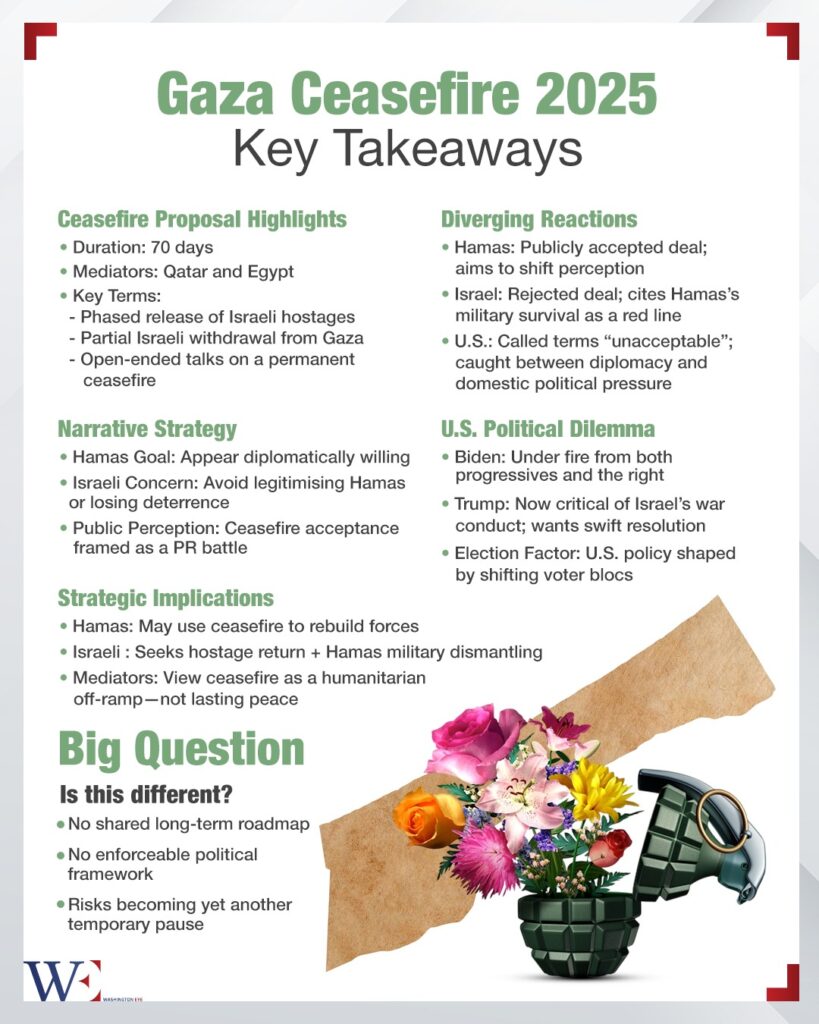When news emerged that Hamas had accepted a new ceasefire proposal mediated by Qatar and Egypt, it landed like a flare in the night—unexpected, momentary, and uncertain in its significance.
Hamas has indicated conditional acceptance of a U.S.-backed proposal that outlines a 60-day truce (though 70 was the original proposal), the phased release of 10 living Israeli hostages and 18 bodies, a partial Israeli withdrawal from Gaza, and the release of Palestinian prisoners. The deal, crafted with American input and regional mediation, also proposes open-ended negotiations toward a permanent ceasefire.
But as with previous efforts, the details are proving more contentious than the headlines. Within hours, Israel dismissed Hamas’s amendments to the proposal—specifically its demand for a full Israeli withdrawal and a guaranteed end to the war—as “totally unacceptable.”
A U.S. envoy echoed this stance, confirming that Hamas’s counterproposal deviated significantly from the version Israel had accepted.
The War Behind the War: Narratives as Leverage
Ceasefire negotiations in Gaza are not only about diplomacy—they’re about narrative warfare. By conditionally accepting the framework and pushing for additional guarantees, Hamas projects itself as the party willing to compromise. The political play is clear: shift international pressure onto Israel.
If Israel continues operations in Rafah—particularly after the May 31 strike near a food distribution point that killed over 30 people—it risks further reinforcing global perceptions of obstinance. The Red Cross reported receiving nearly 180 casualties at its Rafah field hospital, underlining the humanitarian consequences of the ongoing offensive.
This form of narrative positioning is familiar. Hamas has repeatedly used public “acceptance” of truce terms as leverage, knowing that rejection by the opposing side fuels international scrutiny. Even if the deal collapses, the group benefits from reinforcing its image as diplomatically engaged, under siege, and wronged.
Israel’s Red Lines and Washington’s Balancing Act
Israel’s refusal to entertain Hamas’s amendments is anchored in two non-negotiables: the dismantling of Hamas’s military command structure and the unconditional return of all hostages. Any ceasefire that allows Hamas to retain control or rearm is viewed in Jerusalem as a strategic failure.
Meanwhile, the United States is walking a tightrope. President Biden is under pressure to reduce civilian casualties and manage tensions with Arab partners, while still maintaining strong support for Israel. The upcoming U.S. election complicates the matter: a ceasefire viewed as too generous to Hamas risks backlash from pro-Israel constituencies. On the other hand, former President Donald Trump—once a staunch Netanyahu ally—has begun to distance himself, criticizing the war’s prolongation and calling for a decisive end. His shift signals changing sentiments among Republican voters and places Biden in a difficult political bind, pressed by both progressive Democrats and segments of the GOP.
Ceasefires as Tactical Breathers
Historically, ceasefires in Gaza serve more as temporary pauses than enduring solutions. For Hamas, a truce is a strategic breather to rebuild and regroup. For Israel, it helps mitigate global outrage while preserving deterrence. For mediators like the U.S., Egypt, and Qatar, it is a necessary but fragile step to avoid an escalating humanitarian catastrophe.
Yet a ceasefire alone is not a resolution. The deeper question remains whether either side envisions a political pathway beyond the battlefield. Is there a framework—credible, enforceable, and internationally backed—that can transition Gaza from siege and destruction to long-term stability? Thus far, no such blueprint has emerged.
The internal dynamics within Hamas further complicate the landscape. Following the deaths of senior commanders, new figures like Izz al-Din al-Haddad (Abu Suhaib) have taken up military leadership in Gaza. These transitions could impact how ceasefire commitments are interpreted and enforced—raising doubts about continuity, control, and coherence within the group’s ranks.
Still Waiting for a Breakthrough
As it stands, the ceasefire proposal may offer a temporary pause, but it is far from a breakthrough. Without clear mechanisms for implementation, accountability, and political vision, the latest round of negotiations risks becoming just another waypoint in a war marked by cyclical devastation.
The question isn’t just whether the guns fall silent. It’s whether silence leads to anything more than the next round of fighting.
So far, the answer—yet again—is: not yet.
















